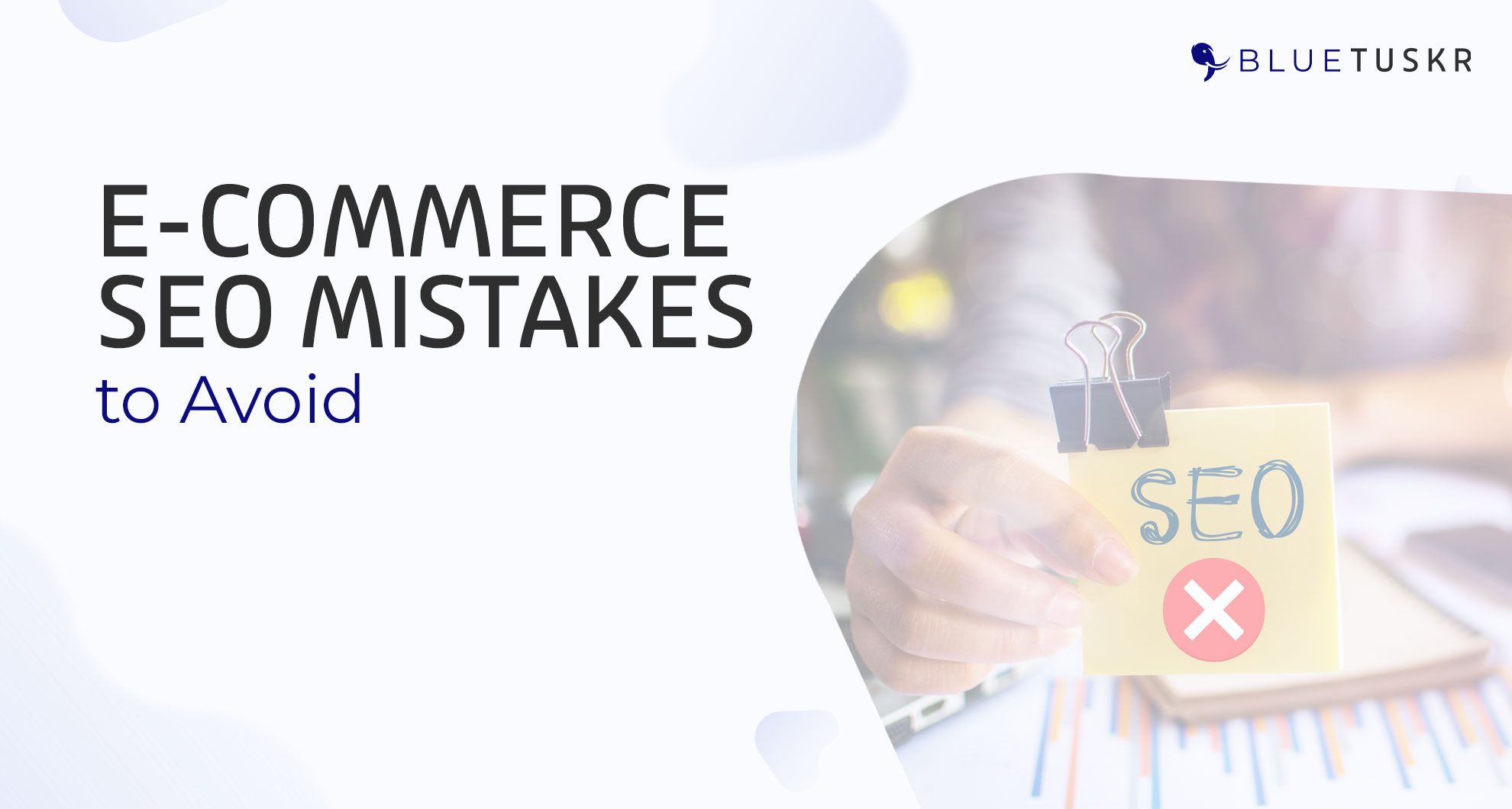
10 E-commerce SEO Mistakes to Avoid
In the competitive world of e-commerce, search engine optimization (SEO) is a critical component that can determine the success or failure of your e-commerce websites or online store. Optimizing your e-commerce sites for search engines not only helps attract organic traffic but also enhances user experience and ultimately boosts sales. However, many e-commerce businesses fall into common SEO pitfalls that can hinder their growth.
The good news is that most e-commerce mistakes can be avoided with proper awareness. These mistakes range from not diversifying your products to not optimizing your product pages for search engines. This guide highlights these common mistakes and provides actionable advice to help you avoid them.
Most Common SEO Mistakes in E-commerce
Here, we've compiled a list of common e-commerce SEO mistakes to avoid so that you can get your online store up and running as fast, smoothly, and successfully as possible.
1. Investing In the Wrong E-commerce Platform
Your content management system plays a crucial role in your e-commerce business. If you choose a platform that isn't scalable, versatile, or user-friendly enough for your e-commerce stores needs and growth potential, then it can be detrimental to your business in the long run.
To avoid this mistake, first do some research on what different platforms offer so you know which one will best suit your needs.
Once you've chosen your CMS platform, read the features of the platform thoroughly before investing in an e-commerce theme and solution so that you know what features to expect.
The last thing you want is to invest substantial time, money, and energy into a CMS only to realize that it lacks the essential features needed for your e-commerce website. If this occurs, you'll face the daunting task of spending additional resources to switch to an appropriate e-commerce platform.

2. Poor Website Design and Navigation
A well-designed website with intuitive navigation is fundamental to the success of your e-commerce business. Poor website design and navigation frustrate users and adversely affect your SEO efforts.
Search engines prioritize user experience, which includes factors such as ease of navigation, site structure, and overall design aesthetics. When a website is difficult to navigate, users are likely to leave quickly, increasing your bounce rate—a metric that search engines use to gauge the relevancy and quality of your page.
From an SEO perspective, an unwieldy site structure makes it hard for search engine crawlers to index your pages efficiently, leading to poor visibility in search results. If key pages remain hidden deep within the site architecture, they're less likely to be indexed and ranked. Additionally, a confusing layout and a poor site structure can disrupt internal linking strategies, further impeding crawl efficiency and SEO performance.
To avoid this mistake, ensure your site design is user-centric with clear navigation pathways. Implement a logical hierarchy with well-defined categories and subcategories, keep navigation menus simple and consistent, and ensure your site is mobile-friendly and looks consistent across different browsers.
3. Lack of Mobile Optimization
Mobile optimization is no longer optional but a necessity in today's digital age. According to eMarketer, over 60% of US adults believe that mobile shopping is essential for convenience in online shopping. This trend is only expected to continue growing in the coming years. Therefore, not optimizing your website for mobile devices can severely hinder your e-commerce sales.
Another reason for considering mobile optimization is that Google has adopted a mobile-first indexing policy, which means the search engine predominantly uses the mobile version of the content for indexing and ranking. Websites that aren't mobile optimized may suffer in search engine rankings, leading to decreased visibility and organic traffic.
From an SEO perspective, a lack of mobile optimization can also affect page load times, which is another critical search ranking factor. Mobile users are more likely to abandon a site that takes too long to load, increasing your bounce rate and, again, negatively affecting your SEO metrics.
To avoid this mistake, ensure your e-commerce website is responsive, meaning it automatically adjusts to fit the screen size of the device being used. Additionally, employ practices such as optimizing images, using mobile-friendly navigation menus, and minimizing the use of large files or complex elements that slow down your e-commerce site.
4. Slow Website Speed
In today's fast-paced digital environment, consumers expect websites to load quickly; a delay of even a few seconds in initial page load can lead to significant drops in conversions and an increase in bounce rates. Research by Google indicates that as page load time goes from one to ten seconds, the probability of a mobile site visitor bouncing increases by 123%.
From an SEO standpoint, website speed is a crucial ranking factor. Google has made it clear that faster sites provide a better user experience and rank higher in search engine results. Therefore, slow-loading pages can decrease a website’s visibility, resulting in lower search rankings.
To avoid this mistake, invest in optimizing your website speed. This includes practices such as compressing images, minifying code, leveraging browser caching, and using a content delivery network (CDN). Also, regularly monitor your site's performance and address any issues causing delays in load times.
Focusing on these aspects will result in a faster, more efficient website, which will improve user satisfaction and search engine performance.

5. Ignoring Keyword Research
Keyword research is the cornerstone of any successful e-commerce SEO strategy. Ignoring it can have significant repercussions for your online store. Keywords are the terms and phrases that potential customers use when searching for products. Without a robust keyword strategy, your e-commerce stores may fail to appear in search results, drastically reducing their visibility and organic traffic.
When you neglect keyword research, you're missing out on understanding your target audience's language. This gap can lead to content that doesn't align with search queries or user intent, making it less likely for search engines to rank your pages. Consequently, even if you offer high-quality products, your lack of keyword optimization means that potential customers might never find them.
To avoid this pitfall, invest time in thorough keyword research. Use tools like Google Keyword Planner, Google Search Console, Semrush, or Ahrefs to see search demand and identify relevant keywords with high search volume and low competition. Additionally, be sure to use long-tail keywords and avoid overly competitive keywords.
Once you have a list of your target keywords, incorporate them naturally into your product pages, title tags, meta descriptions, headers, and content to improve your search engine rankings and attract targeted traffic.
6. Poor Quality Content
Poor quality content is a fundamental e-commerce SEO mistake that can significantly hinder your online store's performance.
High-quality content is critical for engaging your audience, building trust, and improving your search engine rankings. When your content lacks depth, accuracy, and relevance, it fails to attract and retain visitors. It sends negative signals to search engines, resulting in lower rankings and reduced visibility.
Writing Weak Descriptions
Product descriptions are a crucial element of e-commerce content. They inform potential customers about your products, clarify doubts or concerns, and drive conversions.
Poorly written product descriptions that lack detail and fail to address key features can result in low conversion and high return rates. From an SEO perspective, generic or duplicate descriptions can also cause issues. If you use the same description as other retailers, search engines may not rank the meta description of your page highly, as they prioritize unique content.
To avoid this SEO mistake, invest time and effort into crafting compelling, unique product descriptions. Describe your products in detail, highlight their features and benefits, and add any relevant keywords to improve their visibility in search results.
Why Keyword Stuffing is Bad
Although writing quality content is crucial, overloading it with keywords is counterproductive. Keyword stuffing—cramming a webpage with excessive keywords to manipulate search engine rankings—can severely harm your conversion rate optimization (CRO) efforts.
This outdated and unethical SEO tactic results in a poor user experience, rendering the content unreadable and unappealing. When visitors encounter such content, they are more likely to leave your site quickly, leading to higher bounce rates and lower conversion rates.
Search engines employ sophisticated algorithms that detect keyword stuffing and penalize websites that engage in this practice by lowering their rankings.
To avoid these pitfalls, focus on creating high-quality, user-centric content that naturally incorporates keywords and offers genuine value to your target audience. Additionally, avoid duplicate content to maintain your site's integrity and performance.
7. Neglecting Backlink Profiles
Backlinks, also known as inbound links, are among the most influential factors in search engine rankings. They represent when other websites link to your content, signaling to search engines that your site is authoritative and trustworthy.
However, neglecting backlink profiles can be a critical e-commerce SEO mistake. Failing to build and maintain a diverse portfolio of high-quality backlinks can result in lower search engine rankings and less organic traffic.
Without a robust backlink profile, your website may struggle to compete with other sites that have more links from reputable sources. Moreover, missing out on opportunities to build relationships with other websites means you could miss out on valuable referral traffic.
To avoid this mistake, invest time cultivating high-quality backlinks from relevant and authoritative sources. You can do this through creating valuable and shareable content, guest blogging on reputable sites, or building relationships with other businesses in your industry.

8. Having A Long Checkout Process
When selling your products on e-commerce sites, it's crucial to make the checkout process as quick and seamless as possible. A lengthy or complicated checkout can easily discourage customers from completing their purchases, resulting in lost sales.
One key improvement you can make is streamlining the steps required to complete a purchase. For instance, if customers already have an account, they shouldn't need to re-enter their information. Even a guest checkout should be as simple as possible.
Enhance your checkout process by eliminating hidden costs and unexpected fees, offering multiple shipping options, integrating various payment gateways, and including popular payment methods to facilitate purchases. Tools like PayPal and Shopify can further expedite the process, minimizing customers' time entering credit card details.
To increase conversion rates, test your checkout process with tools like Optimizely to identify the most efficient and user-friendly options.
9. Not Using Analytics to Monitor Your Website and Competition
Analytics tools are essential for understanding your website's performance, customer behavior, and sales data. They enable informed decision-making and strategic optimization. Without analytics, you are essentially running your business blindly, missing critical insights that reveal what works and what doesn't. This can result in missed opportunities, wasted marketing budget, and reduced revenue.
By leveraging analytics, you can track key performance indicators (KPIs), identify trends, adjust your approach, and stay competitive in the ever-evolving e-commerce landscape.
In addition to utilizing analytics, you must monitor your competition to avoid critical e-commerce SEO mistakes. Competitive analysis helps you identify market trends, discover new keywords, understand pricing strategies, and benchmark your performance.
Use tools like SEMrush, Ahrefs, and Google Alerts to regularly monitor your competitors and adjust your strategy to maintain a competitive advantage. Staying aware of industry activities ensures you proactively address challenges and seize new growth opportunities.
10. Not Building Social Media Presence
One last but crucial e-commerce mistake to avoid is neglecting social media marketing. Platforms like Facebook, Twitter, Instagram, TikTok, and Pinterest offer accessible avenues to promote your brand, helping to attract potential customers interested in your products or services.
Social media can significantly influence SEO by boosting website traffic, enhancing brand awareness and reputation, and generating more backlinks. For instance, sharing a blog post on platforms like Facebook or LinkedIn can lead to increased shares, thereby driving more traffic to your website.
Wrapping Up
In conclusion, avoiding these ten common e-commerce SEO mistakes can significantly impact your website's performance and overall success.
By creating high-quality, user-centric content, focusing on technical SEO, optimizing your site's structure and design, building a robust backlink profile, streamlining the checkout process, leveraging analytics and competitive analysis, and maintaining a strong social media presence, you can improve your website's visibility, attract more traffic, increase conversions and ultimately drive business growth.
Ready to improve your e-commerce SEO? Conduct a thorough audit of your current efforts and implement the changes outlined in this article.
Don't hesitate to contact our e-commerce marketing agency for more expert advice and tailored e-commerce SEO solutions. Let's grow your e-commerce business together!
Connect With Us
Recent Post

.png)







Tell us what you think!